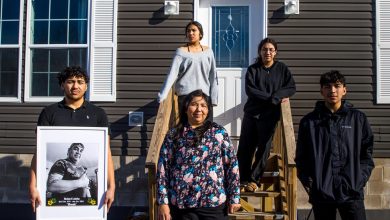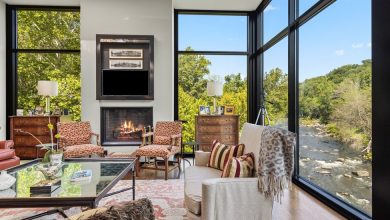Fieldston, the Bronx: A Private City Enclave Where Rocks Are the Stars

What might hinder an area’s development at one point in time can eventually make it stronger. Consider Fieldston, the affluent private neighborhood in the northwest corner of the Bronx.
Start with its rocks. The large slabs that jut from yards in the quarter-square-mile neighborhood got in the way of early planners; as the rest of New York grew through the centuries, Fieldston stayed largely the same. But today those knobs of gneiss, as the stones are known, help define this coveted residential area. Rippled, rough-hewed and fuzzed with plants, the outcrops are standout features of front lawns, even as the houses that sit atop them can be so elevated that their front doors are a full story above the sidewalk.
“There’s a magic to Fieldston,” said John Rusk, 59, who upon first encountering the stony scene, while on a trick-or-treating visit in 1995, was reminded of Montana, where he grew up.
About a decade later, he and his wife, Mary Kocy, traded their condo in Manhattan’s Inwood section for a slate-roofed five-bedroom house in Fieldston. Mr. Rusk said the couple considered Dutchess County, but it was too far from work in Manhattan, as was Westchester.
Air-conditioner units had dripped on the house’s stucco walls over the years, necessitating repairs, which can be tricky in the neighborhood. Because a historic district envelops almost all of Fieldston, any exterior fixes must be approved by local officials. But Mr. Rusk, who owns a contracting firm where Ms. Kocy, 65, is a partner, met the challenge. The house, which cost $1.2 million in 2006, is worth near $2.1 million today, he said.
The sense of community seems to have improved, too. For years, Fieldston, which is a looser, urban version of a homeowners’ association — residents own the streets and pay dues, though visitors can go there to drive, bike and jog (just no student drivers) — could feel a bit aloof, some say. Mr. Rusk and Ms. Kocy, who have two daughters, often got blank stares when greeting neighbors while out for strolls. “One night, we were walking down the street, and some people said, ‘You’re the people who always say hello,’” Mr. Rusk laughed. “‘We’ve heard about you.’”

Fieldston’s rocky terrain initially vexed the area’s developers. But over time those rocks came to define the neighborhood’s aesthetic. Many houses are built around them — and, occasionally, on top of them.Credit…Karsten Moran for The New York Times
As younger families replace old-timers, Fieldston may be warming up. Neighborhood parties are now a thing, and a house tour that drew a few dozen this year seems poised to become an annual tradition.
Often, what lures those families is the proximity to three top private schools, known as the “Hill Schools”: Horace Mann, Ethical Culture Fieldston School and Riverdale Country School. Because Manhattan-based parents with children enrolled in the schools are increasingly able to have flexible work schedules, some of them are packing their bags for Fieldston to reduce their kids’ commute, brokers say.
Among them are Anthony Abdy, 45, and his wife, Natalia, 45, who for several years had to endure all three of their sons going back and forth by bus and car between an Upper East Side rental and Horace Mann. In Fieldston, where they live now, walking is the more common form of transportation.
“We decided to take the stress out of it for them,” said Mr. Abdy, the chief executive of a tile and stone company. It didn’t hurt that Fieldston can provide a bigger bang for one’s buck. For $1.9 million, the Abdys were able to buy a four-bedroom, Mediterranean-style house built in 1931 with a fireplace and verdant yard. “Fieldston is sort of suburban but still part of the city,” he said. “It’s really the perfect blend.”
What You’ll Find
There’s leafy, and then there’s Fieldston. So many tree branches arch over roads that the sky can seem to vanish, at least in summer. Many of those trees, which have their own arborist, are thought to date back to the development of the neighborhood, which began in 1909. And the foliage isn’t random — an arboretum level of curation has reserved certain species for specific streets. Horse chestnuts tower over West 245th, while black gums rib College Road. And Fieldston Road, the median-lined main strip, offers sugar maples on its western side and tulip poplars on the east.
If the greenery and the gently curving streets recall Central Park, it’s no accident. Frederick Law Olmsted, one of the park’s designers, put in his two cents about what Fieldston’s landscape should look like, on behalf of the property’s developer, the Delafield family, in 1876.
Fieldston has not one lick of commercial zoning, nor any multifamily buildings. Pushback over an attempt to build an apartment building in 1938 led to the single-family-only zoning that endures today. Decades later, another wave of objections arose over Fieldston’s attempt to become a landmark, including from some in the Jewish community, who called it an effort to keep out Orthodox families that might want to expand. Nevertheless, in 2006 the city’s Landmarks Preservation Commission voted to make Fieldston a historic district, restricting the changes homeowners could make to their houses.
Columns mark the entrances to the area controlled by the Fieldston Property Owners’ Association, the neighborhood’s official boundary, which aligns almost perfectly with the borders of the historic district. Residents consider Fieldston to be distinct from Riverdale, which surrounds much of it like a doughnut.
Holding up the more than 250 houses in Fieldston are many walls made of fieldstone. Architectural historians often describe these castle-like walls as having a distinct style: “Medieval.”But more traditional looks pop up, too, like 4455 Tibbett Avenue, a red-tile-roof Craftsman-style residence that’s considered the area’s oldest house. It dates to 1912, when it was constructed for Albert Wheeler, the civil engineer responsible for Fieldston’s layout.
What You’ll Pay
Inventory is typically low in this affluent enclave, and prices steep, though more houses are becoming available.
In November, 11 houses in Fieldston were listed at an average of $2.35 million, according to StreetEasy. At the low end was a five-bedroom house built in 1927 and needing some care, at $1.3 million. The priciest was a nine-bedroom Tudor-style home near the Henry Hudson Parkway, built in 1928 and since expanded, with exposed beams, a stone turret and two separate apartments. Its asking price was $3.5 million.
While the pandemic hampered sales in its early days, there has since been a blitz of activity, which has sent prices soaring. From January to November of this year, Fieldston saw 16 houses change hands at an average price of $2.22 million, according to Trebach Realty, a local firm. In all of the prepandemic year of 2019, by comparison, there were 14 sales at an average of $1.68 million.
“Though Fieldston tends to sell generationally, the pandemic skewed things,” said Brad Trebach, an associate broker. “The neighborhood has emerged stronger.”
Annual dues to the Fieldston Property Owners’ Association, which are calculated based on a house’s street frontage, run between $2,500 and $3,800 for snowplowing, street-cleaning and security, residents say.
The Vibe
Fieldston residents may not have corner restaurants to eat in like most New Yorkers, but they do have unique green spaces like Delafield Park, a shady grove between Livingston Avenue and Indian Road, whose centerpiece is a fieldstone-rock-ringed pond. Turtles and koi are occupants.
Every fall since 2015, the park, which is in the midst of a restoration, has hosted a party for residents, though the pandemic put a halt to the fun in 2020. A scaled-back version with cider and doughnuts happened a couple of months ago.
Beyond the neighborhood’s borders are more typical offerings. On Riverdale Avenue and Johnson Avenue, which stretch into Kingsbridge from Fieldston’s southern edge, you’ll find restaurants serving sushi, Nuevo Latino cuisine, Greek food and Italian favorites.
Also nibbling on Fieldston’s southern edge is Manhattan College, whose 22-acre campus accommodates about 3,700 students — though Fieldston is hardly their college town. Students tend to party at bars closer to Broadway, to the east.
Across Broadway is Van Cortlandt Park, which at 1,146 acres is the city’s third-largest park.
The Schools
Fieldston is zoned for P.S. 81, the Robert J. Christen School, which offers kindergarten through fifth grade just north of the neighborhood. Enrollment is around 730. In 2018-19, 68 percent of students met standards on state English exams, versus 48 percent citywide. In math, 68 percent met standards, versus 50 percent statewide.
For middle school and high school, the zoned option is Riverdale Kingsbridge Academy, which serves grades six through 12 on West 237th Street, to the south. At the high school, the student population in 2020 was 54 percent Hispanic, 26 percent white, 10 percent Black, 8 percent Asian and 1 percent Native American, according the New York City Department of Education. SAT reasoning test scores for 2019 were 528 in reading and writing, and 515 in math, versus 491 and 496 citywide.
About 800 students attend the middle school portion. On 2018-19 state exams, 54 percent of students met standards in English, as compared with 47 percent citywide, while 55 percent met standards in math, versus 41 percent.
Among the private options, the highest-profile is probably Horace Mann, on West 246th Street. In 1887, when it opened in Greenwich Village, tuition was $150 a year; today, it’s about $57,000, and 15 percent of students receive financial aid, according to the school. Close by is the Bronx campus of the Ethical Culture Fieldston School, which offers prekindergarten through 12th grade, for about $58,000 a year, its website says, with 22 percent of students receiving financial aid. And one of two Bronx campuses of Riverdale Country School is also in the neighborhood, enrolling students in grades six through 12. Tuition is $51,000, according to the school, with 20 percent receiving aid.
The Commute
The Riverdale stop on the Hudson line of Metro-North Railroad is about a five-minute drive away. Between 6 a.m. and 9 a.m., it offers 10 trains to Grand Central Terminal. The trip takes between 31 and 37 minutes, and a monthly pass is $216. For those who drive to the station, a yearly parking pass is $372.
There are also three express buses that run along the Henry Hudson Parkway to Manhattan; two serve Midtown and one goes to Lower Manhattan. Fares are $6.75, though less off-peak.
And the 1 train stops at West 242nd Street, at Broadway.
The History
In 1829, Major Joseph Delafield purchased a 257-acre swath of land stretching from the Hudson River to Van Cortlandt Park — once part of Westchester. Fieldston, named for a family estate in Ireland, carved off one piece of the estate. Columbia University inherited a 13-acre chunk and sold it to developers in the 1970s.
What’s believed to be the only surviving structure from the original estate stands just outside Fieldston, across the Henry Hudson Parkway. The Italianate building, at 6 Ploughmans Bush, is believed to have been a Delafield hunting lodge, according to the city’s Landmarks Preservation Commission, which held a vote in 2009 for it to become a landmark. It failed. Last winter, the house sold for $878,600 to a buyer shielded by a limited liability company, records show.
For weekly email updates on residential real estate news, sign up here. Follow us on Twitter: @nytrealestate.





